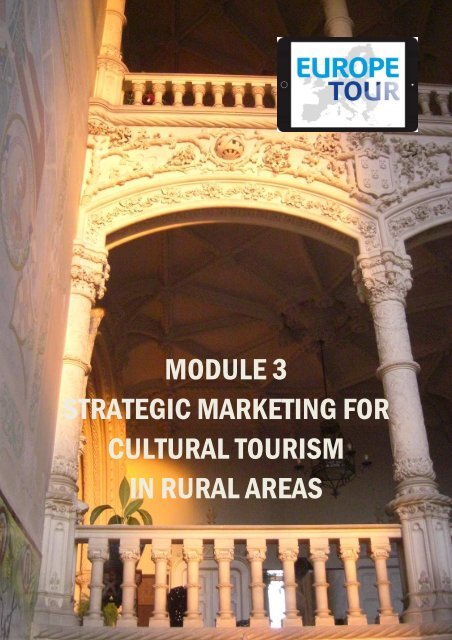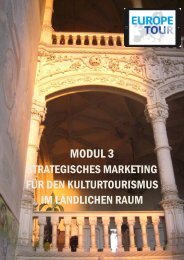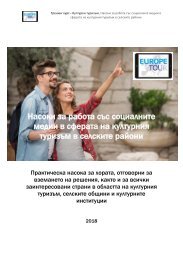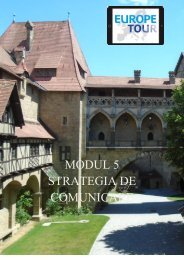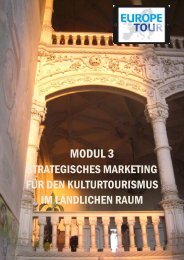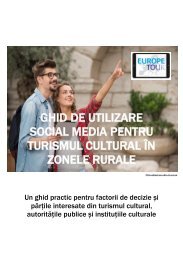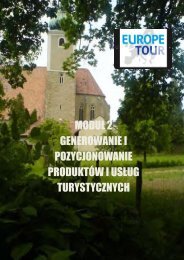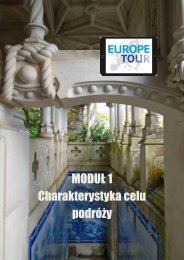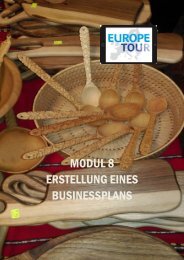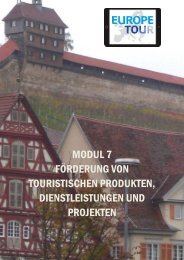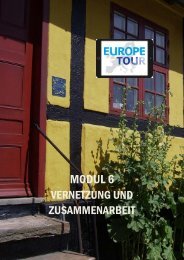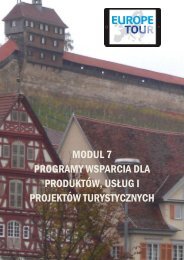Module_3_Marketing_Strategy
You also want an ePaper? Increase the reach of your titles
YUMPU automatically turns print PDFs into web optimized ePapers that Google loves.
CULTURAL TOURISM TRAINING COURSE<br />
MODULE 3 - STRATEGIC MARKETING IN CULTURAL TOURISM<br />
MODULE 3<br />
STRATEGIC MARKETING FOR<br />
CULTURAL TOURISM<br />
IN RURAL AREAS<br />
6
CULTURAL TOURISM TRAINING COURSE<br />
MODULE 3 - STRATEGIC MARKETING IN CULTURAL TOURISM<br />
This Training <strong>Module</strong> is part of the Cultural Toursim Training Course which has been developed within<br />
the Erasmus+ Strategic Partnership EUROPETOUR, a European initiative aimed at unlocking the economic<br />
potential of Europe’s outstanding cultural treasures and empowering rural areas to harvest the<br />
potential of cultural tourism.<br />
You can find more information at the homepage: http://www.europetour.tips<br />
Pictures: Wolfgang Eisenreich, Kees Grootswagers, Elena Paschinger<br />
This work is licensed under a Creative Commons Attribution-NonCommercial-ShareAlike 4.0 International<br />
License.<br />
You are free to:<br />
• share — copy and redistribute the material in any medium or format<br />
• adapt — remix, transform, and build upon the material<br />
under the following terms:<br />
• Attribution — You must give appropriate credit, provide a link to the license, and indicate if<br />
changes were made. You may do so in any reasonable manner, but not in any way that<br />
suggests the licensor endorses you or your use.<br />
• NonCommercial — You may not use the material for commercial purposes.<br />
• ShareAlike — If you remix, transform, or build upon the material, you must distribute your<br />
contributions under the same license as the original.<br />
The European Commission support for the production of this publication does not constitute an endorsement of the contents which<br />
reflects the views only of the authors, and the Commission cannot be held responsible for any use which may be made of the information<br />
contained therein.<br />
Project number: 2015-1-DE02-KA202-002325<br />
7
CULTURAL TOURISM TRAINING COURSE<br />
MODULE 3 - STRATEGIC MARKETING IN CULTURAL TOURISM<br />
Contents<br />
Strategic marketing concerns the future development of a touristic enterprise or a destination. The<br />
main task is to adapt the current situation to the suspected development.<br />
This module focuses on the strategic aspects of marketing for cultural tourism in rural areas.<br />
Unit 1 Basics of strategic marketing<br />
Unit 2 Methods for strategic analysis<br />
Unit 3 Strategic objectives in cultural tourism<br />
Unit 4 <strong>Strategy</strong> development<br />
Learning objectives<br />
At the end of this <strong>Module</strong>, you will know the various focus points for strategic tourism marketing.<br />
You have been introduced into strategic thinking.<br />
You will know which types of strategic analysis are most suitable for your business.<br />
You will understand how the development of your strategic objectives is linked with your vision and<br />
mission.<br />
You will learn the difference between vision statement and mission statement.<br />
You will see that corporate identity is more than just about design.<br />
You will be able to reflect on your own strategies and adapt them accordingly.<br />
You will learn about the components of your strategy mix.<br />
8
CULTURAL TOURISM TRAINING COURSE<br />
MODULE 3 - STRATEGIC MARKETING IN CULTURAL TOURISM<br />
Unit 1<br />
Basics of Strategic<br />
<strong>Marketing</strong><br />
9
CULTURAL TOURISM TRAINING COURSE<br />
MODULE 3 - STRATEGIC MARKETING IN CULTURAL TOURISM<br />
Basics of Strategic <strong>Marketing</strong><br />
Strategic marketing concerns the future development of a touristic enterprise or a destination. In the<br />
context of this module, cultural institutions are regarded as “touristic enterprises” as well. This may<br />
sound strange, but in fact cultural insti-tutions like museums, collections, orchestras or theatres are<br />
offering a paid service or products to their visitors or an audience. The expression “enterprise”<br />
contains an economic dimension, which is conciously chosen as the majority of the products and<br />
services are not offered for free.<br />
The main task is to adapt your current situation to the suspected development and to the intended<br />
objectives. Such strategies can be compared with future oriented guarding rails for the daily management<br />
of a touristic enterprise, lea-ving clearance for short term tactic manoeuvres.<br />
The result of strategic marketing is a marketing concept that includes<br />
three different levels of concretisation:<br />
1. the objectives as future scenario (the future place)<br />
2. the strategies as structure (the road to this place)<br />
3. the marketing mix as process (the vehicle to get there)<br />
Strategies are long-term decisions or specifications that determine the frame-work of your organization’s<br />
or destination’s policy, usually with a time frame of five to ten years. They are large scale<br />
and they determine structures.<br />
Short term marketing planning is tactic marketing and covers a time frame of approximately one year.<br />
It refers to certain defined measures and details.<br />
Neither short nor long term marketing is completely rigid and irreversible; it must be constantly<br />
checked for success and adapted to the respective market development. As rapidly as consumers’<br />
tastes change, so must marketing strategies.<br />
Strategic thinking and acting is a combination of<br />
1. applied knowledge of marketing management know-how<br />
2. logical thinking by following logical conclusion from market<br />
analysis<br />
3. creativity by developing the right ways for the future and by<br />
coordinating them accordingly.<br />
10
CULTURAL TOURISM TRAINING COURSE<br />
MODULE 3 - STRATEGIC MARKETING IN CULTURAL TOURISM<br />
Strategic cultural tourism management leads s to acting instead of reacting!<br />
The basic characteristics of strategic thinking are<br />
• visionary thinking: to recognize future possibilities<br />
• differentiation thinking: to be different from the competition, to search for uniqueness, to head<br />
for innovation instead of imitation<br />
• advantage thinking: to search for competitive advantages<br />
• directional thinking: to search for options for the future, to identify alternative ways how to<br />
reach the goal<br />
• potential thinking: to recognize and understand influence factors<br />
These various aspects of strategic thinking have led to a number of different strategy building blocks.<br />
The most widely known are<br />
• Unique Selling Proposition<br />
• Strategic Business Unit<br />
• Strategic Success Position<br />
• Comparative Competition Advantage<br />
The basic strategic task is to recognize and develop these strategy building blocks for your products<br />
and services.<br />
Exercise 13<br />
Strategic marketing: before and after<br />
This exercise is mainly for beginners.<br />
Step 1:<br />
Before you study the following units, write down which strategic marketing activities you have<br />
undertaken so far.<br />
Step 2:<br />
After completing the unit, make a plan which activities you will undertake in the near future<br />
11
CULTURAL TOURISM TRAINING COURSE<br />
MODULE 3 - STRATEGIC MARKETING IN CULTURAL TOURISM<br />
Unit 2<br />
Methods for<br />
Strategic Analysis<br />
12
CULTURAL TOURISM TRAINING COURSE<br />
MODULE 3 - STRATEGIC MARKETING IN CULTURAL TOURISM<br />
Methods for Strategic Analysis<br />
Depending on the type of your business, you may employ various types of ana-lysis. In this unit, we<br />
will present the most useful methods for strategic analyses that will help to understand the internal<br />
and external starting position and the development possibilities.<br />
SWOT Analysis<br />
The SWOT Analysis is a frequently used planning tool that investigates a context by examining the<br />
(S)trengths, (W)eaknesses, (O)pportunities and (T)hreats. The analysis assesses challenges and<br />
opportunities by both internal and external fac-tors.<br />
Graphic: Sam Thatte Presentation Design<br />
Internal:<br />
• Strengths. What advantages does my business have over others?<br />
Examples: Unique assets in terms of culture, history, environment, built infrastructure, quality,<br />
operations, business environment, community support and buy-in, diversity of offers, bargain,<br />
name recognition, human resources, accessibility, government support; ...<br />
• Weaknesses. What might account for losing visitors to the competition?<br />
Examples: Poor transportation, gang activity, many mosquitoes during high season, conflicts<br />
among stakeholders, historic monument highly deteriorated, ...<br />
13
CULTURAL TOURISM TRAINING COURSE<br />
MODULE 3 - STRATEGIC MARKETING IN CULTURAL TOURISM<br />
External:<br />
• Opportunities. Which upcoming trends could benefit the site?<br />
Examples: Developing travel trends that cater to strengths of the site, changes in demographics<br />
favourable to the destination, economic situation changing to shift visitor patterns to<br />
destination, ...<br />
• Threats. Which upcoming trends could hurt the site?<br />
Examples: Opening of new highly competitive destinations, recession, new law imposing high<br />
visa fees on visitors, budget cut from public money, ...<br />
The tourism landscape constantly changes internally and externally. The SWOT analysis, if used<br />
correctly, can direct attention and reflection toward aspects of the context that may have been<br />
overlooked or underappreciated. The results can become substantial raw material for further destination<br />
marketing.<br />
Situation analysis<br />
Next, you should identify the strengths and weaknesses of your cultural tourism business or<br />
destination. An effective marketing is constantly taking inventory of its strengths and weaknesses.<br />
The six key techniques which you can use for completing the situation analysis are:<br />
• Destination or product/product development analysis<br />
• Competitive analysis<br />
• Visitor market analysis<br />
• <strong>Marketing</strong> position and destination image analysis<br />
• <strong>Marketing</strong> plan analysis<br />
• Resident analysis<br />
Destination Analysis<br />
A destination analysis (also sometimes called a product analysis) is a careful assessment of the<br />
strengths and weaknesses of your cultural organisation or the destination, ideally based on inputs from<br />
a variety of sources within and outside the destination.<br />
You should develop a set of criteria for analysing the destination. As example, we show the set of<br />
criteria from the Travel and Tourism Competitiveness Report 2011 produced by the World Economic<br />
Forum. It lists the following fourteen criteria for ranking country destinations:<br />
1. Policy rules and regulations<br />
2. Environmental sustainability<br />
3. Safety and security<br />
4. Health and hygiene<br />
5. Prioritization of travel and tourism<br />
6. Air transport infrastructure<br />
7. Ground transport infrastructure<br />
8. Tourism infrastructure<br />
9. ICT infrastructure<br />
10. Price competitiveness in the travel and tourism industry<br />
14
CULTURAL TOURISM TRAINING COURSE<br />
MODULE 3 - STRATEGIC MARKETING IN CULTURAL TOURISM<br />
11. Human resources<br />
12. Affinity for travel and tourism<br />
13. Natural resources<br />
14. Cultural resources.<br />
Competitive Analysis<br />
A competitive analysis is another important element in cultural tourism marke-ting planning and<br />
research. Most competitors vary by target market and there-fore it is best if you divide the competitive<br />
analysis in that way. For example, an organisation may have a different set of competitors for business<br />
conventions and meetings than it has for individual pleasure travellers.<br />
You should have a good perception of your competitors, but the best source are visitors themselves.<br />
Asking visitors in surveys to pinpoint other destinations or providers that they considered for their trips<br />
is one way to tackle this. Another option is to use a focus group approach in which past or potential<br />
visitors reach a consensus on the closest competitors. Be creative in order to find out what kind of<br />
experiences your visitors had with competing institutions – you might also find out that a competitor<br />
could be a partner on a certain topic!<br />
Visitor market analysis<br />
From time to time, i.e. every two to three years, you should undertake a visitor analysis. The<br />
categories of information that this analysis should provide include<br />
• demographic and socio-economic characteristics<br />
• travel trip characteristics (e.g. trip purposes, length of stay, accommo-dation and transportation<br />
usage, etc.)<br />
• Previous visit patterns (number and timing of previous trips)<br />
• Revisit intentions (probability of a return visit)<br />
• Attraction usage and awareness<br />
• Activity participation in your destination<br />
• Travel information sources used for trip to destination<br />
• Media usage (TV; newspapers; magazines; Internet/sociaI media, etc.)<br />
• Trip satisfaction levels<br />
• Likes and dislikes<br />
• Suggested improvements to the destination<br />
<strong>Marketing</strong> position and destination image analysis<br />
You need to understand your image or position in the minds of past and potential visitors. Assess<br />
your organisation’s current offline and online marketing activities and how your destination is<br />
performing against your competition. Unfortunately, this image research is done infrequently and<br />
seldom.<br />
15
CULTURAL TOURISM TRAINING COURSE<br />
MODULE 3 - STRATEGIC MARKETING IN CULTURAL TOURISM<br />
It is rather difficult for you as a (comparably) small cultural institution or tourism desk at a small<br />
municipality or village to implement such a research. But you might ask your next level tourism agency<br />
or the regional government for data and analysis in order to deviate results for your own institution.<br />
<strong>Marketing</strong> plan analysis<br />
The marketing plan analysis involves an objective assessment of your marketing plans. This is done<br />
mainly by evaluating and measuring the effectiveness and re-sults of the previous marketing plan. The<br />
summative evaluation of last period's performance against marketing objectives must answer three key<br />
questions:<br />
• How effective was the last marketing plan?<br />
• Which activities and programnes worked?<br />
• Which activities and programmes did not work?<br />
Be honest! Try to find out which activities did not work and ask colleagues and friends about their<br />
opinion. There might be a very surprising outcome. The evaluation of previous marketing activities and<br />
programmes should yield the answers to these questions.<br />
Resident analysis<br />
Some destinations or tourism providers go one step further and conduct re-search on local resident<br />
attitudes or sentiments about tourism in their commu-nities. This is especially important if tourism<br />
represents a very large part of the local economy and affects residents’ every day life.<br />
Conclusions<br />
The major outcome of all these analyses will give you a clearer understanding of how your institution<br />
or destination is different from its competitors, and how this will be reflected in your marketing<br />
strategy. Competitive strategy (see Unit 4 of this <strong>Module</strong>) is about being different and you must identify<br />
these differences early in your marketing planning.<br />
Sometimes these differences are referred to as “unique selling propositions” (USP), “sustainable<br />
competitive advantages” (SCA) or “differential-distinct competitive advantages”. A sustainable competitive<br />
advantage for your organi-sation or destination means that you have the assets and/or the skills that<br />
meet the following conditions:<br />
• They are valuable to visitors.<br />
• They are rare among the destination's current and potential competitors.<br />
• They cannot be easily copied.<br />
• There are no strategically equivalent substitutes for these assets or skills.<br />
16
CULTURAL TOURISM TRAINING COURSE<br />
MODULE 3 - STRATEGIC MARKETING IN CULTURAL TOURISM<br />
Exercise 14<br />
Create your own strategy<br />
Try to act as a professional marketing specialist and create your own strategy.<br />
1 What are the future prospects of your product / service?<br />
_______________________________________________________________<br />
_______________________________________________________________<br />
_______________________________________________________________<br />
2 What are the main differences of your product / service in comparison with those of competitors?<br />
________________________________________________________________________<br />
________________________________________________________________________<br />
________________________________________________________________________<br />
3 Can you imagine how your product / service will look like in 5 years from now?<br />
_______________________________________________________________<br />
_______________________________________________________________<br />
_______________________________________________________________<br />
4 Can you imagine which influence factors will change your product/service?<br />
_______________________________________________________________<br />
_______________________________________________________________<br />
_______________________________________________________________<br />
If you have many very different products or services, it may be necessary to answer these questions<br />
several times and create a separate profile for each product.<br />
.<br />
17
CULTURAL TOURISM TRAINING COURSE<br />
MODULE 3 - STRATEGIC MARKETING IN CULTURAL TOURISM<br />
Unit 3<br />
Strategic Objectives<br />
in Cultural Tourism<br />
18
CULTURAL TOURISM TRAINING COURSE<br />
MODULE 3 - STRATEGIC MARKETING IN CULTURAL TOURISM<br />
Strategic Objectives in Cultural Tourism<br />
The peculiarity in cultural tourism is that the development of marketing object-tives on the<br />
organisation’s, i.e. on the corporate level, must be embedded into the various levels of the tourism<br />
branch and their national, regional or local tou-rism concepts. These super-ordinated “macro<br />
objectives” set the framework in which you can develop your “micro” objectives, and sometimes they<br />
lead to certain limitations.<br />
A single hotel in a spa would have difficulties if it tries to set a<br />
mar-keting objective to reach young motor bike travellers.<br />
If the regional destination is being marketed under soft tourism,<br />
then the individual providers should arrange for respective operational<br />
targets and offer e.g. ecological hotel management with<br />
electric bike rental.<br />
Members of a touristic association must also respect the<br />
objectives of this umbrella organisation and combine their goal of<br />
profit maximising with the regional goals of e.g. culture tourism<br />
or quality tourism.<br />
Vision statement and mission statement<br />
The development of your strategic objectives is closely linked with your vision and mission.<br />
A vision statement is an exciting picture of your organisation’s desired future which intends to motivate<br />
all collaborators to work together to achieve this future. Visioning is most successful when it is<br />
participatory and when it creates an image that integrates all the separate visions of people involved.<br />
In order for a vision to mobilize resources — which is the ultimate purpose of a vision — it must find<br />
common, higher ground in everybody who sees it as part of his/her future. Only then, a strong vision<br />
can motivate people to work together to achieve what otherwise might be unachievable.<br />
Unfortunately, very often many visions contain only short, bland, meaningless mix-tures of key words<br />
which have been contributed by the different participants. As a result, no one can identify with such<br />
sterile statement and it fails as a project development tool.<br />
19
CULTURAL TOURISM TRAINING COURSE<br />
MODULE 3 - STRATEGIC MARKETING IN CULTURAL TOURISM<br />
Vision statement or mission statement - which comes<br />
first?<br />
If you start up a new cultural touristic business, a new<br />
programme or if you plan to re-engineer your current<br />
products and services, the vision statement will be<br />
formulated first as it will guide the mission statement and<br />
the rest of your strategic plan. For an established business<br />
where the mission is established, often the mission guides<br />
the vision statement and the rest of the strategic plan for<br />
the future.<br />
The mission statement can be regarded as the red thread or the framework for all actions. It consists<br />
of several sentences; each of them gives a clear and distinct statement. The sum of all sentences<br />
gives a full description of the status quo and/or the future.<br />
A mission statement is more than a slogan, it is more detailed and gives more space for information.<br />
The style, content and terminology of mission statements can vary considerably. Some are very long<br />
and detailed whereas others are shorter and to the point. Some focus on a particular audience<br />
(members or visitors) while others are writ-ten with multiple audience in mind. There are no “rights” or<br />
“wrongs” of how it should be presented or what it should contain; it all depends on your organisa-tion<br />
and your culture.<br />
In practice, a mission statement should cover the following:<br />
• Some indication of the business your organisation is mainly concerned with<br />
• An indication of the realistic market share or market position toward which your organisation<br />
aims<br />
• A brief summary of the values and beliefs of your organisation in relation to your key<br />
stakeholders, such as e.g. visitors<br />
• An indication about the ownership<br />
• Your attitude towards social responsibility which can also be expressed in a “code of conduct”.<br />
Cultural tourism should include here also aspects of sustainability.<br />
Effective mission statements<br />
Clearly articulated. The mission statement should be simple<br />
to comprehend so that local and regional stakeholders as well<br />
as visitors can clearly understand the principles and values<br />
which will guide them in their dealings with your<br />
20
CULTURAL TOURISM TRAINING COURSE<br />
MODULE 3 - STRATEGIC MARKETING IN CULTURAL TOURISM<br />
organisation. The statement must be specific enough to have<br />
an impact upon the behaviour of individuals.<br />
Relevant. The mission statement should be appropriate to<br />
your organisation in terms of history, culture and shared<br />
values. The mission should not be too broad and not too<br />
narrow. Too broad may result in lack of focus, too narrow<br />
might mean that important factors are overlooked.<br />
Current. An unchanged mission statement is no longer able<br />
to act as driving force guiding your organisation into the<br />
future.<br />
Positive. The mission statement should be written in such a<br />
way that encourages commitment and inspires your<br />
stakeholders.<br />
Individual. The mission statement should set your<br />
organisation apart from others by establishing its individuality<br />
– or better even: its uniqueness.<br />
Enduring. The mission statement cannot be continually<br />
changed, as this would be confusing. It should remain in<br />
place for several years; so it should be written to allow for<br />
some flexibility.<br />
Mission Statement versus Vision Statement<br />
Mission Statement<br />
Vision Statement<br />
About<br />
A Mission Statement talks<br />
about HOW you will get to<br />
where you want to be. It<br />
defines the purpose and<br />
primary objectives related to<br />
your customer needs and<br />
team values.<br />
A Vision Statement outlines<br />
WHERE you want to be. It<br />
communicates both the<br />
purpose and values of your<br />
business.<br />
Answer<br />
It answers the question,<br />
“What do we do? What<br />
makes us different?”<br />
It answers the question,<br />
“Where do we aim to be?”<br />
Time<br />
A Mission Statement talks<br />
about the present leading to<br />
its future.<br />
A Vision Statement talks<br />
about your future.<br />
Function<br />
It lists the broad goals for<br />
which the organization is<br />
It lists where you see yourself<br />
some years from now. It<br />
21
CULTURAL TOURISM TRAINING COURSE<br />
MODULE 3 - STRATEGIC MARKETING IN CULTURAL TOURISM<br />
Mission Statement versus Vision Statement<br />
Mission Statement<br />
formed. Its prime function is<br />
internal; to define the key<br />
measure of the organization's<br />
success and its<br />
prime audience is the leadership,<br />
team and stockholders.<br />
Vision Statement<br />
inspires you to give your best.<br />
It shapes your under-standing<br />
of why you are working here.<br />
Change<br />
Your Mission Statement may<br />
change, but it should still tie<br />
back to your core values,<br />
customer needs and vision.<br />
As your organization evolves,<br />
you might feel tempted to<br />
change your vision. However,<br />
mission or vision statements<br />
explain your organization's<br />
foundation, so change should<br />
be kept to a minimum.<br />
Developing a<br />
statement<br />
What do we do today? For<br />
whom do we do it? What is<br />
the benefit? In other words,<br />
Why we do what we do?<br />
What, For Whom and Why?<br />
Where do we want to be<br />
going forward? When do we<br />
want to reach that stage?<br />
How do we want to do it?<br />
Features of an<br />
effective<br />
statement<br />
Purpose and values of the<br />
organization: Who are the<br />
organization's primary<br />
"clients"? What are the<br />
responsibilities towards the<br />
clients?<br />
Clarity and lack of ambiguity:<br />
Describing a bright future<br />
(hope); Memorable and<br />
engaging expression; rea-listic<br />
aspirations, achievable;<br />
alignment with organiza-tional<br />
values and culture.<br />
Source: http://www.diffen.com/difference/Mission_Statement_vs_Vision_Statement<br />
22
CULTURAL TOURISM TRAINING COURSE<br />
MODULE 3 - STRATEGIC MARKETING IN CULTURAL TOURISM<br />
Corporate identity<br />
Your vision and your mission are integral parts of your identity. Named corporate identity, it is a<br />
central element in marketing and in reaching the strategic object-tives. Your cultural or touristic<br />
organisation stands for a uniform and clear pic-ture that distinguishes it from its competitors; e.g.<br />
“young, progressive” or “re-liable, conservative”.<br />
The most widely spread misunderstanding is that corporate identity is just about design.<br />
Illustration: Freyer: Tourismus <strong>Marketing</strong>, Oldenburg Verlag, München 2011<br />
Corporate identity consists of three components:<br />
1. Corporate design: The visual appearance of your organisation. It con-tains recurrent identical<br />
or similar elements, such as logo, fonts, colours, which appear in all communications (letters,<br />
posters, flyers, internet, etc.)<br />
2. Corporate behaviour: The behaviour how actions are performed, e.g. “the guest is king”. It<br />
should be coherent in dealing with all areas, whether as provider, employer, in social aspects,<br />
and in the environment of the organisation<br />
3. Corporate Communication: The implementation of your corporate identity to the interior and<br />
exterior environment.<br />
You will find more about Corporate Identity in <strong>Module</strong> 5.<br />
23
CULTURAL TOURISM TRAINING COURSE<br />
MODULE 3 - STRATEGIC MARKETING IN CULTURAL TOURISM<br />
Some questions to ask during the visioning:<br />
How do you see your destination after cultural tourism development?<br />
What do you want to see happen?<br />
What is an acceptable level of change in your community?<br />
How much of what type of tourism development fits with your image of your<br />
destination’s future?<br />
What future state of cultural tourism gets you really excited to think about?<br />
Exercise 15<br />
Mission statement<br />
Read the mission statement of the managing director of Tourism Australia and try to draft your own<br />
vision / mission statement. You will find the link at the end of this <strong>Module</strong> in the Best Practice section.<br />
Discuss it with your co-workers and implement it in your organisation.<br />
.<br />
24
CULTURAL TOURISM TRAINING COURSE<br />
MODULE 3 - STRATEGIC MARKETING IN CULTURAL TOURISM<br />
Unit 4<br />
<strong>Strategy</strong> Development<br />
25
CULTURAL TOURISM TRAINING COURSE<br />
MODULE 3 - STRATEGIC MARKETING IN CULTURAL TOURISM<br />
<strong>Strategy</strong> Development<br />
In the light of the diverse marketing requirements for cultural tourism in rural areas, you will most<br />
certainly need an integrative approach when you develop your marketing strategy. Actually, you need<br />
to consider – and develop - several types of strategies:<br />
• Development strategies<br />
• Competition strategies<br />
• Customer strategies<br />
The result of these strategic possibilities is your strategy mix.<br />
Many cultural touristic institutions and destinations perform undifferentiated marketing; they address the<br />
entire market without knowing whom they would reach with their strategy and how. They want to reach<br />
with one or a low number of products as many visitors as possible. Such mass marketing does not<br />
even work with big travel agencies, tour operators and big destinations. Such global strategies (“all for<br />
everybody”) bear the risk of a missing profile which makes the offer interchangeable. For cultural<br />
tourism, mass marketing is an absolute “no go” and the market would punish you heavily if you try.<br />
Therefore it is better, especially for smaller organisations in rural areas, if you opt for selective or<br />
differentiated marketing. With this approach, you will have the advantage of being really competent in<br />
your market, you will be able to develop unique selling propositions; and competitors will have a more<br />
difficult access to this market.<br />
The advantage of such approach is that it requires no market analysis and mar-ket research.<br />
Development strategies<br />
Many people fear that strategic operations mean to make everything “new and different”. However,<br />
most strategies build upon existing offers and aim at secu-ring a position at the market in the future.<br />
Several possibilities exist:<br />
• Growth strategy: depends on your resources and is often limited by existing infrastructure and<br />
by ecological or social boundaries.<br />
• Stabilisation strategy: Because of the aforementioned limitations, it is often important to think<br />
of maintaining the same volume, but to think of quali-tative growth instead. A museum might<br />
not increase the number of visitors, but could have an attractive museum shop and thus<br />
increase the income.<br />
• Shrinkage strategy: This need not be a sign of defence or crisis. A supply shortage may lead<br />
to higher prices and thus to better economic results.<br />
Another development strategy is the timing strategy: It makes a big difference if you are a pioneer and<br />
the first in the market or if you enter a market after it has been accepted by customers.<br />
26
CULTURAL TOURISM TRAINING COURSE<br />
MODULE 3 - STRATEGIC MARKETING IN CULTURAL TOURISM<br />
Competitive strategies<br />
Here you look at your own market position vis-à-vis your competitors. Depending on the situation, you<br />
might decide for more aggressive or more cooperative strategies, depending on whether you plan to<br />
enlarge your market share or to defend it.<br />
In aggressive strategies you will use your own strengths. This may concern<br />
• Quality leadership: you use your your success position or USP as an asset.<br />
• Cost leadership: if you have cost advantages over your competitor, then you could employ<br />
aggressive pricing strategies, but this not a qualified option for cultural tourism.<br />
You can also opt for a niche strategy through specialisation where you try to ob-tain price advantages.<br />
Me too strategy: This strategy lies between aggressive and cooperative strategies and applies in<br />
developed markets that offer enough “space” for more providers.<br />
In many cases, providers prefer a cooperative strategy: Several – mostly equally large – providers try<br />
together to build the market. They enter into cooperation, networks and strategic alliances and achieve<br />
cost advantages in joint purchase and advertising. For cultural tourism, this is the most beneficial<br />
strategy.<br />
Customer strategies<br />
These strategies deal with market segmentation according to target groups. Seg-mentation criteria can<br />
be done along various criteria, e.g. along<br />
• socio-demographic segmentation<br />
• segmentation according to travel styles<br />
• psychographic segmentation<br />
Another possibility could be to segment your market according to the principal reason for travel:<br />
• recreational and leisure travel<br />
• visiting friends and relatives<br />
• business travel<br />
• adventure, cultural heritage, and experiential travel and, of course,<br />
• cultural interests<br />
These groups have implications in terms of length of stay, intensity of travel, ac-commodation<br />
preference, predisposition to spend money, and general choice of activities.<br />
Markets can then be segmented by additional tourist-specific methods such as demographics,<br />
psychographics, and spending patterns or behaviors. Look at the visitor survey on the following pages!<br />
The methods for segmentation are often combined to create richer and nuanced visitor profiles that<br />
permit even more targeted marketing and product development. In other words, the more marketers<br />
know about the desired experience, the more they should refine their products and advertising to meet<br />
a visitor’s desires, needs, and expectations.<br />
27
CULTURAL TOURISM TRAINING COURSE<br />
MODULE 3 - STRATEGIC MARKETING IN CULTURAL TOURISM<br />
Here is one example: Backer Spielvogel Bates Advertising developed three market segments that consist<br />
of demographic, psychographic, and behavioral qualities:<br />
Source: Solimar 2011<br />
28
CULTURAL TOURISM TRAINING COURSE<br />
MODULE 3 - STRATEGIC MARKETING IN CULTURAL TOURISM<br />
VISITOR SURVEY QUESTIONNAIRE<br />
This example has been modified from: Tourism Destination Management. Achieving sustainable and<br />
competitive results.<br />
http://lms.rmportal.net/course/category.php?id=51<br />
29
CULTURAL TOURISM TRAINING COURSE<br />
MODULE 3 - STRATEGIC MARKETING IN CULTURAL TOURISM<br />
30
CULTURAL TOURISM TRAINING COURSE<br />
MODULE 3 - STRATEGIC MARKETING IN CULTURAL TOURISM<br />
31
CULTURAL TOURISM TRAINING COURSE<br />
MODULE 3 - STRATEGIC MARKETING IN CULTURAL TOURISM<br />
32
CULTURAL TOURISM TRAINING COURSE<br />
MODULE 3 - STRATEGIC MARKETING IN CULTURAL TOURISM<br />
Exercise 16<br />
Which strategies do you employ?<br />
Describe for each of the following strategies what has been done in your organisation?<br />
Development strategies<br />
________________________________________________________________________<br />
________________________________________________________________________<br />
Competitive strategies __________________________________________________<br />
________________________________________________________________________<br />
Aggressive strategies<br />
________________________________________________________________________<br />
________________________________________________________________________<br />
Cooperative strategies<br />
________________________________________________________________________<br />
________________________________________________________________________<br />
Me-too strategies<br />
________________________________________________________________________<br />
________________________________________________________________________<br />
Customer strategies<br />
________________________________________________________________________<br />
________________________________________________________________________<br />
.<br />
33
CULTURAL TOURISM TRAINING COURSE<br />
MODULE 3 - STRATEGIC MARKETING IN CULTURAL TOURISM<br />
.<br />
Champing<br />
a special accommodation for<br />
heritage lovers<br />
Why is this a Best Practice?<br />
The British Churches Conservation Trust has developed an accommodation option that uniquely<br />
combines travel experience and preservation of the cultural heritage: "Champing" means overnight stays<br />
in historic churches at camping conditions, and is currently being offered in three atmospheric ancient<br />
churches. Visitors appreciate the experience of the nightly coolness, the silence of the churches and<br />
the sur-rounding nature. Candles serve as a moody lighting, the noises of the night are condensed to<br />
sleep. In the morning, a generous country breakfast awaits the guest.<br />
Champing churches are a time journey back into Anglo-Saxon history. They are a very special setting<br />
to discover England's centuries-old culture, the regional heritage and craftsmanship. This opens up the<br />
possibility of a direct contribution of tourism to the preservation of the historic churches.<br />
The Churches Conservation Trust cooperates with local parishes and their members.<br />
https://www.visitchurches.org.uk/visit/champing.html<br />
34
CULTURAL TOURISM TRAINING COURSE<br />
MODULE 3 - STRATEGIC MARKETING IN CULTURAL TOURISM<br />
.<br />
Textile Center Haslach<br />
Why is this a Best Practice?<br />
In addition to its established tradition as a linen weaving market, the Austrian city of Haslach (2350<br />
inhabitants) in the rural Mühlviertel region has made a name for a contemporary textile centre in the<br />
past 20 years, which can be attributed to the activities of the "Textile Kultur Haslach" association. As<br />
early as 1990, a group of textile enthusiasts joined forces to create a platform for the contemporary<br />
explo-ration of diverse textiles and their production and to promote international ex-change. The basic<br />
idea was to stimulate new impulses in a place with textile roots by inviting highly qualified textile<br />
designers and artists from abroad. A bridging between art and domestic industry was to be created,<br />
and the local population was included by various public actions. Meanwhile, the museum with numerous<br />
activities is situated in a former linen production centre. Activities all over the year are an attraction<br />
for visitors from Austria, Germany and the close Czech Republic. The well-known weavers’ market is<br />
now frequented by 10,000 visitors every year on a week-end in July.<br />
The Textile Center is constituted with five partners: a weaving museum, an asso-ciation, a social<br />
enterprise, an education center and a production unit for small product series. It is supported by<br />
public institutions and private entities. The Centre also has a network of friends and sponsors with<br />
active or financial contributions.<br />
Products and services: exhibitions, guided tours, courses, a weavers’ market, cooper-ation with a<br />
university, local farmers and producers<br />
An English folder can be found at: http://www.textiles-zentrum-haslach.at<br />
35
CULTURAL TOURISM TRAINING COURSE<br />
MODULE 3 - STRATEGIC MARKETING IN CULTURAL TOURISM<br />
Code of conduct<br />
Why is this a Best Practice?<br />
If you are working in a larger organisation, the views and vision of the management cannot be<br />
transferred to all employees by direct and daily contact. This code of conduct covers all aspects of<br />
professional collaboration:<br />
• corporate values and behaviours, ethical conduct, ethical decision-making<br />
• respect for the law, harassment, bullying and discrimination, reporting wrongdoing<br />
• conduct at work functions, conduct in social media<br />
• official information, power and privileges, intellectual property<br />
• official facilities, equipment and other resources<br />
• government relations, political material and activities<br />
• conflicts of interest, secondary employment<br />
• entertainment expenditure and working meals<br />
• non-compliance, acceptance of the code<br />
•<br />
Find the whole document<br />
https://www.google.at/#q=%22Tourism+Australia%22+%22welcome+from+the+managing+director%22&*&<br />
spf=1<br />
36


